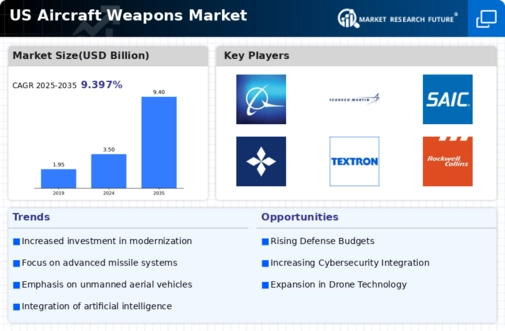The US Aircraft Weapons Market is a multifaceted and highly competitive sector characterized by significant innovation, advanced technologies, and a diverse range of products designed to meet the ever-evolving needs of military and defense capabilities. Various key players in this market incorporate extensive research and development efforts, along with robust operational efficiencies, to strengthen their positions. Companies are continually adapting to changes in defense spending, geopolitical situations, and technological advancements by integrating cutting-edge solutions into their offerings. Competitive dynamics in this market are dictated by strategic partnerships, mergers, and acquisitions that enhance capabilities, streamline production processes, and expand market reach.
The interplay of these factors shapes not only the market landscape but also influences the procurement strategies of the US Department of Defense and allied nations.Raytheon Technologies has established itself as a formidable leader in the US Aircraft Weapons Market through its commitment to innovation and technological excellence. Renowned for its advanced missile systems, targeting systems, and electronic warfare capabilities, Raytheon Technologies leverages its extensive R&D investments to deliver solutions that meet stringent military requirements. The company benefits from its legacy in the aerospace and defense sector, coupled with partnerships that enhance its market presence.
Its longstanding relationships with the US government and a robust development pipeline position Raytheon Technologies favorably within the competitive landscape. The company’s proficient use of advanced manufacturing techniques and emphasis on sustainability further bolster its reputation, providing it with a competitive edge in delivering highly effective defense solutions.Huntington Ingalls Industries is another key player in the US Aircraft Weapons Market, recognized for its expertise in designing and manufacturing naval vessels as well as providing various defense-related services. The company's primary offerings include advanced missile systems and integration technologies specifically tailored for aircraft and maritime platforms.
Huntington Ingalls Industries has a strong market presence due to its established contracts with the US Navy and other defense agencies, resulting in a solid foundation for growth in the aircraft weapons sector. Its strengths lie in comprehensive engineering capabilities, a skilled workforce, and a commitment to innovation. Recent mergers and acquisitions have further enhanced the company's portfolio and operational efficiencies, allowing it to better respond to the market's demands. This strategic approach to expanding capabilities positions Huntington Ingalls Industries favorably within the US Aircraft Weapons Market, establishing it as a vital contributor to national defense objectives.


















